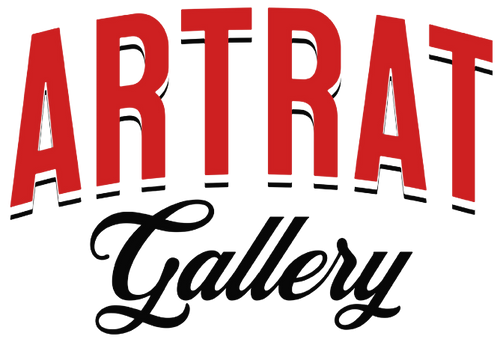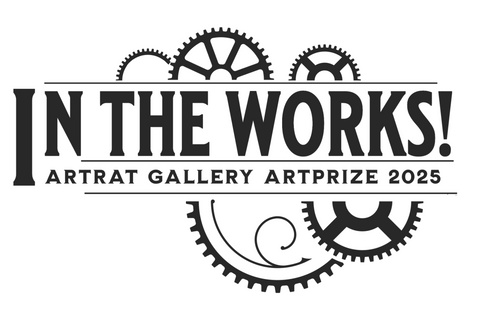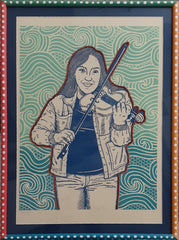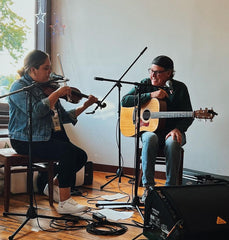Sunday, April 7, ArtRat Gallery hosts the next installment of its roots music series curated by The Stableford Agency. Americana Sundays: An Afternoon With Ruby John and John Warstler runs 3-5pm at 46 Division Ave. S in the heart of downtown Grand Rapids. (Admission $20; tickets available from Eventbrite.)
Ruby John is a traditional fiddler and a member of the Grand Traverse Band of Ottawa and Chippewa Indians. Ruby learned to play from many Michigan fiddlers. and at numerous music camps and workshops throughout Michigan and Ontario, Canada. Ruby plays a variety of styles, including Old Time, French Canadian, Métis, Irish and Bluegrass.
Ruby made her ArtRat debut at the event that inspired Americana Sundays: an ArtPrize 2022 appearance with Nic Gareiss and Gray Reynolds. (The three performed to support Gray’s ArtPrize submission, “Grace Notes,” which featured portraits of folk musicians from historically marginalized communities.)
Ruby and guitarist John Warstler will present a variety of fiddle tunes, sing some songs, and tell stories of Ruby's journey to blend her fiddling and her Native heritage.
Ahead of Saturday’s show, Ruby talked with ArtRat about her creative journey across musical traditions.
When you first took up the fiddle and tapped into the folk traditions behind it, I understand that some people in your native community disapproved. How do you view the relationship between indigenous culture and folk culture informed by Europe?
Yes, when I was young I did get picked on in my own community — but through the years it has changed, and I have my whole community's support and am loved for being a fiddle player. How I view it, I think fiddling is for all.
I don’t think you need to be a part of a certain culture to want to play fiddle. If it speaks to you and you find joy in it, do it! Fiddling for me has opened up my world and I’ve been able to learn about many cultures.
Describe your experience learning fiddle traditions of the Métis (Canadian descendents of 18th century European fur traders and First Nations women).
Fiddling and dancing traditions are very strong in Métis communities. I first became aware of it from the documentary Medicine Fiddle, which interviewed Métis and indigenous fiddlers on the border of the US and Canada.
Being an indigenous fiddler in Michigan on the border of Canada, I related. Also, the fiddlers in that documentary were elders, and as a indigenous girl I grew up learning from elders, so watching the movie. It felt as if I were learning from elders as I did in my own community.
I never thought I’d meet any of the fiddlers from that film, but I did. I met and learned from three of them: Lawrence "Teddy Boy" Houlé, Rene Cote and Frank Boyer. Although I never met Coleman Trudeau, I played music with one of his family members and met his family.
Also at 18, I was a part of Métis Elder Youth project that Anne Leaderman (a wonderful fiddler from Toronto) put together.
What distinguishes Métis fiddle from other North American forms?
Métis and Indigenous fiddle styles have a very rhythmic feel. The bowing is very rhythmic. It’s hard to explain in words.
You perform Sunday with guitarist John Warstler. Do you play together often? What can the audience expect from Sunday's show?
Yes, John Warstler and I have performed together a lot. We have been in multiple bands together, including a dance band (The Johns) and an acoustic country band (Ruby and The Retros), and we’ve performed together as a duo for many years. On Sunday, we will be doing a variety of driving fiddle styles, and tunes I’ve learned from my mentors in Michigan. We’ll also have a few original songs to add to the mix!





